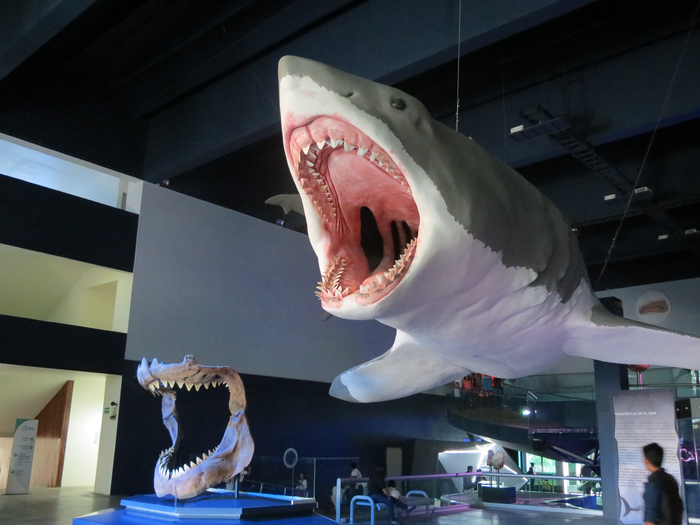Megalodon may have been killed off by great white sharks, study suggests
Smaller species gobbled up same prey as its monstrous cousin, scientists believe
Megalodon, the biggest shark that ever lived, may have been killed off thanks to the success of the great white, new research suggests.
A study of elemental traces in their teeth implies the huge sea monster faced competition for resources from its smaller and more nimble rival, say scientists.
Examination of fossils suggests the two species chased the same animals, including whales, dolphins and porpoises. Experts said further study was now needed to establish just how fierce the competition was.
Professor Kenshu Shimada, of DePaul University, Chicago, said: “These results likely imply at least some overlap in prey hunted by both shark species.”
Analysis of zinc levels found they were at the top of the food chain, meaning nothing ate them.
An international team generated a database of values across 20 living and prehistoric shark species ranging from aquarium and wild individuals to megalodon.
Co-author Professor Michael Griffiths, of William Paterson University, New Jersey, said: “Our results show both megalodon and its ancestor were indeed apex predators, feeding high up their respective food chains.
“But what was truly remarkable is zinc isotope values from Early Pliocene shark teeth from North Carolina suggest largely overlapping trophic levels of early great white sharks with the much larger megalodon.”

Zinc in tooth enameloid, which is the highly mineralised portion, revealed the degree of animal matter consumption. Results were found to be as reliable as the more established nitrogen examination of collagen – the organic tissue in dentine.
Lead author Dr Jeremy McCormack, of Goethe-University Frankfurt, said: “On the timescales we investigate collagen is not preserved, and traditional nitrogen isotope analysis is therefore not possible.”
Prof Thomas Tutken, of Johannes Gutenberg University in Mainz, added: “Here we demonstrate, for the first time, that diet related zinc isotope signatures are preserved in the highly mineralised enameloid crown of fossil shark teeth.”
The study in Nature Communications compared zinc levels in numerous extinct shark species from megalodon’s era with those of modern counterparts.
They also looked at ratios in megalodon teeth and its ancestors’ as well as today’s great white sharks to shed light on their impact on past ecosystems – and each other.
Prof Sora Kim, of the University of California Merced, said: “We noticed a coherence of zinc isotope signals in fossil and modern analogue taxa, which boosts our confidence in the method and suggests there may be minimal differences in zinc isotope values at the base of marine food webs, a confounding factor for nitrogen isotope studies.”

New isotope methods such as zinc are promising tools to investigate diet, ecology and evolution in other fossil marine vertebrates - providing a unique window into the past.
Dr McCormack added: “Our research illustrates the feasibility of using zinc isotopes to investigate the diet and ecology of extinct animals over millions of years, a method that can also be applied to other groups of fossil animals - including our own ancestors.”
Could megalodon still lurk in our oceans?
Megalodon was three-and-a-half times bigger than the great white shark, reaching 65ft in length and weighing more than 50 tons.
Its serrated seven-inch teeth and the occasional vertebrae are all that remain because sharks’ skeletons are made of cartilage, which rarely survives fossilisation.
The giant predator dominated the oceans between 23 million and 3.6 million years ago and its sudden extinction has puzzled evolutionary experts for decades. Young animals, already a monstrous 6ft at birth, would have been particularly vulnerable to starvation.
It has been suggested megalodon could still be alive – as in the 2018 Hollywood blockbuster The Meg starring Jason Statham.
Prof Shimada said that was impossible. As a warm-water species, it would not be able to survive in the cold waters of the deep, likely the only place it could go unnoticed.
He said: “While additional research is needed, our results appear to support the possibility for dietary competition of megalodon with Early Pliocene great white sharks.”
That affinity for warm water has been posited as another possible cause of megalodon’s demise – if Earth’s climate had cooled markedly it would have reduced habitat space for the 50ft giants.
SWNS
Join our commenting forum
Join thought-provoking conversations, follow other Independent readers and see their replies
Comments


Bookmark popover
Removed from bookmarks